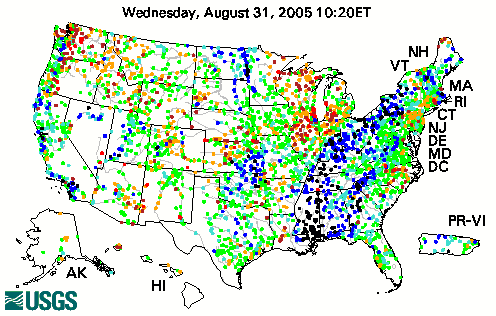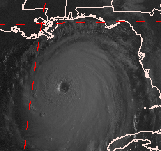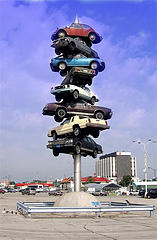“I’m not asking anybody to panic,” said Gov. Mike Easley. “If I find out we need to panic, I’ll come back and tell you tomorrow.” (here)
Monthly Archives: August 2005
BlogDay
 For Blogday. I enjoy the blogs of people who practice a craft and write about it; for example Spirits Dancing is the blog of an artist in Australia. “My husband’s grandfather had a wide notion of what might be fixed with paint, and it got more extensive as he got older, until he was happily fixing stains in upholstery and carpets with dabs of paint.”
For Blogday. I enjoy the blogs of people who practice a craft and write about it; for example Spirits Dancing is the blog of an artist in Australia. “My husband’s grandfather had a wide notion of what might be fixed with paint, and it got more extensive as he got older, until he was happily fixing stains in upholstery and carpets with dabs of paint.”
 Two blogs that skim off the cream from the long tail. Global Voices out of harvard is providing a slight glimpse of what the real world is like; it tends to be a bit more political than I’d like “In Bangladesh, Futurebanglanetwork is cynical about the World Bank’s motivations when it comes to lobbying against a SIM card tax.” For something completely different Xupacabras is almost entirely arty photographs of nude women and certainly not safe for work; it provides an excellent portal for finding the sites of amazing photographers.
Two blogs that skim off the cream from the long tail. Global Voices out of harvard is providing a slight glimpse of what the real world is like; it tends to be a bit more political than I’d like “In Bangladesh, Futurebanglanetwork is cynical about the World Bank’s motivations when it comes to lobbying against a SIM card tax.” For something completely different Xupacabras is almost entirely arty photographs of nude women and certainly not safe for work; it provides an excellent portal for finding the sites of amazing photographers.
The author of Open Brackets is a translator who grew up Canada and lives in france. I particularly love how many times she will revise any given posting. “Although most of us would probably like to think that grand philosophical leitmotifs thread their way through our lives (ethical dilemmas and a steady but glorious plod to some form of wisdom), an obscenely large portion of solitary meditation is in fact taken up by the pettiest of thoughts ”
And finally pubsub. Pubsub isn’t a blog, it’s kind of search engine You give it a query and it gives you back a rss feed. I love to make queries of combinations of words and see what comes out. For example I got the posting from the “real yellow pages” suggesting that it’s very important to keep your phone book close at hand when preparing for a hurricane. Or the posting that there is a ranking for colleges based on reports of how healthy their squirrel population is. I love the sendipity of these feeds. I tend to have a 20 at any given time, churning all the time. Pick an unusual word, for example right now I’m watching “unwatering” or a pattern of words (for example: (“duck boat” OR “duckboat” OR “cruise ship”) AND katrina) and see what happens.
More fun at: Feedster, Technorati, IceRocket, BlogPulse, Del.icio.us
A GARLAND OF PRECEPTS
A GARLAND OF PRECEPTS
by Phyllis McGinley
Though a seeker since my birth,
Here is all I’ve learned on earth,
This is the gist of what I know:
Give advice and buy a foe.
Random truths are all I find
Stuck like burs about my mind.
Salve a blister. Burn a letter.
Do not wash a cashmere sweater.
Tell a tale but seldom twice.
Give a stone before advice.
Pressed for rules and verities,
All I recollect are these:
Feed a cold to starve a fever.
Argue with no true believer.
Think-too-long is never-act.
Scratch a myth to find a fact.
Stich in time saves twenty stitches.
Give the rich, to please them, riches.
Give to love your hearth and hall.
But do not give advice at all.
Here we go again.
Here’s a contest. Name the actions the administration could take which serve their agenda but have little if any relevance to actual problems that need to be addressed. For example I just listened on the radio and the administration is relaxing environmental protections (you know so we can increase the fuel supply) and suspending labor work rules (you know so we can respond more vigorously).
Or maybe FEMA could direct donations to Pat Robertson’s (you know the guy the close personal friend of Charles Taylor who likes to suggest taking out foreign leaders and supreme court justices) operation blessing. Here just for example are at least 30 legitimate places to to donate.
Or yeah, it’s five days after it the national hurricane center forecast this catastrophe, time to get back to work on repealing the estate tax. If only we could find a rich corpse!
But wait, how about we eliminate the minimum wage.
Reverse Flash Flood

In the southwestern united states they warn you about flash floods in the canyons. Storms dump a few inches of water at someplace upstream and this water is then aggregated into a giant pulse of water that sweeps down thru the canyon your standing in, killing you. The sky is clear and there is very little warning, maybe just a slight increase in the flow before the flood passes thru.
I’ve always been a fan of this realtime stream flow data network the government runs. It allows them to make accurate forecasts for the downstream flooding. The black dots on this chart show the gages pinned to their maxiumum. A number of gages aren’t reporting.
The tree like networks that draw the water out of river basins and down to the sea are made up of billions of links. Each segement of the stream another link. These networks are powerlaw distributed, the mighty rivers at their roots the hubs of thier distribution systems.
On Monday morning I filled the cars with gas, topping them up to capture the last of the gas at last weeks prices. I was actually surprised that none of the gas stations had raised their prices. Gas on the wholesale market in New York was already up and I assumed that station owners would reprice that huge expensive asset each morning. One guy I asked said “Later, we do it around midday.” Another guy said “The boss hasn’t come in yet.”
This morning we were awoken by a sound you don’t hear in the summer. The oil truck was delivering oil across the street. A few minutes ago another oil truck filled the tank of another neighbor. I don’t know if that my neighbor’s topping up, or if it’s their oil guys pushing oil out to their customers so they can, in turn, top up their tanks.
This is an interesting example of the long tail at work. The moment that supply shifts from abundant and dependable to scarce and volitile everybody along the entire distribution system changes their behavior. They address the volitility risk by adding reserves to their storage capacity, but they also shift capital into oil and gas because of the perception that their price will be higher in the future. I.e. it’s a good investment to top up my car’s gas tank or for my neighbors and their oil guy to top up their storage tanks.
This is a facinating example of the long tail at work. If the entire periphery of the distribution system tops up it’s as if the river basin suddenly starts running up hill. The calculations about risk and future values changes for each and every link in the entire distribution chain.
Unbelievable
URGENT – WEATHER MESSAGE
NATIONAL WEATHER SERVICE NEW ORLEANS LA
1011 AM CDT SUN AUG 28 2005..DEVASTATING DAMAGE EXPECTED
HURRICANE KATRINA
A MOST POWERFUL HURRICANE WITH UNPRECEDENTED
STRENGTH…RIVALING THE INTENSITY OF HURRICANE CAMILLE OF 1969.MOST OF THE AREA WILL BE UNINHABITABLE FOR WEEKS…PERHAPS LONGER. AT
LEAST ONE HALF OF WELL CONSTRUCTED HOMES WILL HAVE ROOF AND WALL
FAILURE. ALL GABLED ROOFS WILL FAIL…LEAVING THOSE HOMES SEVERELY
DAMAGED OR DESTROYED.THE MAJORITY OF INDUSTRIAL BUILDINGS WILL BECOME NON FUNCTIONAL.
PARTIAL TO COMPLETE WALL AND ROOF FAILURE IS EXPECTED. ALL WOOD
FRAMED LOW RISING APARTMENT BUILDINGS WILL BE DESTROYED. CONCRETE
BLOCK LOW RISE APARTMENTS WILL SUSTAIN MAJOR DAMAGE…INCLUDING SOME
WALL AND ROOF FAILURE.HIGH RISE OFFICE AND APARTMENT BUILDINGS WILL SWAY DANGEROUSLY…A
FEW TO THE POINT OF TOTAL COLLAPSE. ALL WINDOWS WILL BLOW OUT.AIRBORNE DEBRIS WILL BE WIDESPREAD…AND MAY INCLUDE HEAVY ITEMS SUCH
AS HOUSEHOLD APPLIANCES AND EVEN LIGHT VEHICLES. SPORT UTILITY
VEHICLES AND LIGHT TRUCKS WILL BE MOVED. THE BLOWN DEBRIS WILL CREATE
ADDITIONAL DESTRUCTION. PERSONS…PETS…AND LIVESTOCK EXPOSED TO THE
WINDS WILL FACE CERTAIN DEATH IF STRUCK.POWER OUTAGES WILL LAST FOR WEEKS…AS MOST POWER POLES WILL BE DOWN
AND TRANSFORMERS DESTROYED. WATER SHORTAGES WILL MAKE HUMAN SUFFERING
INCREDIBLE BY MODERN STANDARDS.THE VAST MAJORITY OF NATIVE TREES WILL BE SNAPPED OR UPROOTED. ONLY
THE HEARTIEST WILL REMAIN STANDING…BUT BE TOTALLY DEFOLIATED. FEW
CROPS WILL REMAIN. LIVESTOCK LEFT EXPOSED TO THE WINDS WILL BE
KILLED.AN INLAND HURRICANE WIND WARNING IS ISSUED WHEN SUSTAINED WINDS NEAR
HURRICANE FORCE…OR FREQUENT GUSTS AT OR ABOVE HURRICANE FORCE…ARE
CERTAIN WITHIN THE NEXT 12 TO 24 HOURS.ONCE TROPICAL STORM AND HURRICANE FORCE WINDS ONSET…DO NOT VENTURE
OUTSIDE!MSZ080>082-282100-
HANCOCK-HARRISON-JACKSON-
1011 AM CDT SUN AUG 28 2005
Dawn – Katrina – catagory 5
 Oh my, Katrina is now a category 5 hurricane. Hopefully she will both weaken a bit and not hit New Orleans.
Oh my, Katrina is now a category 5 hurricane. Hopefully she will both weaken a bit and not hit New Orleans.
New Orleans is like a bowl of chocolate pudding with the city pressing down on it’s skin. You can stand on the street in New Orleans and gaze up and over the levee to watch the huge ships above you..
John McPhee’s most excellent book Control of Nature has a section about all this.
Levees are an beautiful exemplar of public goods. Public goods come in various structures and levees are at one of the extremes. The quality of the levees is defined by the worse section of the leeve. The minimum over the set of all contributions defines the quality. In the early days, during a storm, men would get in a boat and head across the river to break the levees on the other side.
In the last century the Army Core of Engineers has spent vast sums of money keep the Mississippi river flowing past New Orleans. It really badly wants to switch to a different course far to the west.
Later, around noon east coast time
“Mayor Ray Nagin ordered an immediate evacuation Sunday for all of New Orleans … police and firefighters would fan out throughout the city telling residents to get out. … police would have the authority to commander any vehicle or building that could be used for evacuation or shelter … The hurricane’s landfall could still come in Mississippi and affect Alabama and Florida, but it looked likely to come ashore Monday morning on the southeastern Louisiana coast, said Ed Rappaport, deputy director of the National Hurricane Center in Miami. That put New Orleans squarely in the crosshairs.
‘If it came ashore with the intensity it has now and went to the New Orleans area, it would be the strongest we’ve had in recorded history there,” Rappaport said in a telephone interview Sunday morning. “We’re hoping of course there’ll be a slight tapering off at least of the winds, but we can’t plan on that. So whichever area gets hit, this is going to be a once in a lifetime event for them.’… “We’re in for some trouble here no matter what,” he said. (more)
The photo at right is a sheet of plywood driven thru a palm tree by Hurricane Andrew, the last category 5 storm to this the US. More pictures here and here are pictures from Camille another category 5 storm which hit near New Orleans in 1969.
Ker. Ching. – using network effects to dominate tiny markets

In growing markets new buyers lack information to select the best vendor, the one that fits their needs best. In this absence of information they grasp at straws; other measures which they can understand. Proxies for quality. The simplest model for why you get highly skew’d distributions, like those seen in market share numbers, is to have new entrants link to whom ever already has a lot of links. Market share in one time period generates market share in the next; not just a little bit, but a lot! This is why early movers can have so strong an advantage. They can then create a brand – and a brand is nothing if not a proxy for doing the real work checking if a vendor fits your needs.
GapingVoid is yet another blog written by a consultant who’s attempting to puzzle out how the Internet is reshaping his craft. He’s a marketing consultant. For example he’s currently experimenting with liqouring up gatherings of bloggers to see if that rebounds to the benefit of one of his clients, a vineyard. One of his success stories is English Cut, a high end tailor – $4K/suit. This posting muses about how successful that experiment has been. It’s kind of guilty gloating. He quotes an observer who notes how the English Cut has captured the hub for high end tailoring. It’s become the brand in high end tailoring. He also muses that this kind of tailoring isn’t a particularly scalable business; double your customers doubles your work. Which is trouble if you have to do it all by hand yourself.
All this is very mysterious. Clearly blogs inject more information into the market. Since lack of data aids early movers blogs would appear to tempering early the mover advantage of the mindless linking to what ever is popular. But just as clearly blogs don’t do that. One reason they don’t: the blog gets caught up in it’s own early mover effect. Observe any class of blogs and you’ll find few hubs that arrived late to the game. Worse yet the late arriving hubs often appear to be explained by their association with older or larger hub. That skewed distribution means that if your a winner then it’s Ker. Ching. and if your not then your a dead body.
This seems to it implies that the globalization implicit in blogging is very damaging for small players. If the market doesn’t expand tremendously then blogging is just another tool for consolidating an industry. That blogging, in this case, is just another distribution channel – a distribution channel of marcom. Distribution channels define the links, The links lead to the skewed distribution. The skewed distribution creates a pile of dead bodies. Traditionally some industries, like high-end tailoring, because they don’t scale the participants don’t threaten each other and the members can be quite collegial. Enter the internet where the network effects rule and that collegiality at risk. It’s winner take all.
Trip to the Market
 Got to wondering about the cost of that trip to Haymarket. The trip is about 15 miles round trip and I get about 20 miles to the gallon on that drive.
Got to wondering about the cost of that trip to Haymarket. The trip is about 15 miles round trip and I get about 20 miles to the gallon on that drive.
Let’s do this per day. The typical American drives about 30 miles per day. If I’m getting 20 miles per gallon overall then at $2.60/gallon that’s $3.90/day. The insurance is about $1.25/day. The car’s maintenance is about $2.50/day (for example the new tires will cost me $260 over the internet). I estimated the 5$/day depreciation using kbb.com. If capital costs me 5% a year and the car is worth $12K; then the cost of capital is about $1.60 day.
$3.90 -- gas
$5.00 -- depreciation
$2.50 -- maintenance
$1.60 -- cost of capital
$1.25 -- insurance
---------
$12.65 -- Total/day
$.42 -- cost/mile assuming 30 miles/day
The 15 file trip to Haymarket included a dollar for parking so the trip to Haymarket cost about $7.33.
The IRS has 40.5 cents per mile for it’s standard milage rate. While these numbers for new cars are 15 or 25 cents higher.
Taking a cab would have cost about 4-5 times that much. The cost of the bus/subway combo pass is $2.34 per day. One reason I got to thinking about this was that we just shipped my son’s junk off to college and UPS charged a “fuel” surcharge; which let me to wonder what percentage of their costs actually are fuel. Shipping him, i.e. his plane flight, is amazingly cheap. 7.1 cents a mile.
So far I’ve updated this a few times. First because I had the wrong #s for the insurance; particularly because we just dropped my daughter off the insurance. Secondly because I’d forgotten the cost of capital (thanks Martin). Then we decided that the car’s trip computer is very confusing and I had the wrong distance to Haymarket. A few people have argued that my original $1.50/day for maintainance was too low, so I raised that. I originally estimated the depreciation by just playing with the milage; which got about ten cents a mile. I’ve now played with the age of the car and that adds another 7 cents a mile. Mark Denovich provided the autoclub data for new car cost of ownership. 9/13/05: IRS raises the milage rate to 48.5 cents per mile.
And then we have this poor guy.
Urban
 On Fridays I usually go shopping downtown in Boston where we have one of the very few remaining vegtable markets. That shouldn’t be confused with farmers market, the stalls at Haymarket are run by people who’s only goal is to sell you vegtables; cheap, fast, and often crummy. It’s aggressively competitive down there.
On Fridays I usually go shopping downtown in Boston where we have one of the very few remaining vegtable markets. That shouldn’t be confused with farmers market, the stalls at Haymarket are run by people who’s only goal is to sell you vegtables; cheap, fast, and often crummy. It’s aggressively competitive down there.
My house is a first ring suburb. Such suburbs were made possibly by the steam train late in the 19th century. Since steam trains took a while to get up to speed and a while to bring to a stop these suburbs where, originally, surrounded by farms. The farms were driven out, progressivly, by the street car and then the automobile.
It’s a 15 mile drive from my house to Haymarket, or about $4.00 in gas round trip at current prices. It costs me another dollar to park at Haymarket, since there’s a deal. I easily save that much by buying my vegtables, sausage, cheese, etc. inside the competitive market. (Notice that rising gas prices should allow Walmart to raise prices. )
But I mostly do it because I love the dense, crowded, diverse, urban experiance. I like buying my sausage at the butcher with a cat. I like buying my pita bread from the eight year old son of the halal butcher who’s shop is in a basement. I like buying my green pepers from the amazingly old Italian lady, who unlike other vendors tends to sell only 2 or three things each week. And I always enjoy watching the tourists.
 I’m a huge fan of cities. I really dislike the American enthusiasm for the rural. I agree with Steven Johnson’s comment: “I think the long tail premise has a tacit anti-urban bias to it, since it used to require big city scale to find obscure long tail books or albums that are now readily available to anyone with an Internet connection.” I’d go further and argue that all the vast majority of the happy long tail stories involve the emergence of a commercial entity that substitutes for an urban or civic institution; but the story tellers are carefully to remain blind to the risk that such private entities abuse the power that results.
I’m a huge fan of cities. I really dislike the American enthusiasm for the rural. I agree with Steven Johnson’s comment: “I think the long tail premise has a tacit anti-urban bias to it, since it used to require big city scale to find obscure long tail books or albums that are now readily available to anyone with an Internet connection.” I’d go further and argue that all the vast majority of the happy long tail stories involve the emergence of a commercial entity that substitutes for an urban or civic institution; but the story tellers are carefully to remain blind to the risk that such private entities abuse the power that results.
Is the Internet good or bad for cities? Now there’s a question that merits some further work! I think it’s clear that cars, for example, were very bad for cities. Is the Internet better or worse than cars?
For example I find it facinating how the Internet can be a huge help in finding information about vendors and services in low density areas but if you look for similar information in the Bronx, Brooklyn, or down town Boston you find hardly anything. My hypothisis about that has been that vendors seek ways to connect with their customers and that if your issolated then the Internet provides a welcome way to create connections; but if your embedded in a dense urban area then the Internet is only yet another way to create connections.
 Steve has a short article in Discover magazine that takes a look at this question. He talks a bit about how cities enable people to rondevous. So like my hypothisis it’s about connections. But he talks about things that benefit from physical connections. And he talks about how we might be able to build Internet systems, ala meet-up or dodge-ball, which have are synergistic with the city. What I found neat in the essay was the thought that there may well be a class of systems waiting to be built that strengthen and leverage urban density; systems that have little if any value for rural and suburban densities.
Steve has a short article in Discover magazine that takes a look at this question. He talks a bit about how cities enable people to rondevous. So like my hypothisis it’s about connections. But he talks about things that benefit from physical connections. And he talks about how we might be able to build Internet systems, ala meet-up or dodge-ball, which have are synergistic with the city. What I found neat in the essay was the thought that there may well be a class of systems waiting to be built that strengthen and leverage urban density; systems that have little if any value for rural and suburban densities.
If such systems exist it would be a strong argument that the net can be good for cities.
Meanwhile the real mystery is what in the world was the guy in the suit buying six pounds of ginger root for?